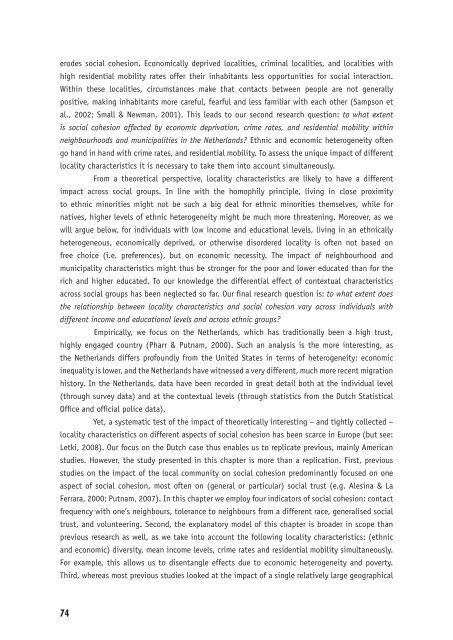Ethnic Hostility among Ethnic Majority and Minority Groups
Ethnic Hostility among Ethnic Majority and Minority Groups
Ethnic Hostility among Ethnic Majority and Minority Groups
You also want an ePaper? Increase the reach of your titles
YUMPU automatically turns print PDFs into web optimized ePapers that Google loves.
erodes social cohesion. Economically deprived localities, criminal localities, <strong>and</strong> localities with<br />
high residential mobility rates offer their inhabitants less opportunities for social interaction.<br />
Within these localities, circumstances make that contacts between people are not generally<br />
positive, making inhabitants more careful, fearful <strong>and</strong> less familiar with each other (Sampson et<br />
al., 2002; Small & Newman, 2001). This leads to our second research question: to what extent<br />
is social cohesion affected by economic deprivation, crime rates, <strong>and</strong> residential mobility within<br />
neighbourhoods <strong>and</strong> municipalities in the Netherl<strong>and</strong>s? <strong>Ethnic</strong> <strong>and</strong> economic heterogeneity often<br />
go h<strong>and</strong> in h<strong>and</strong> with crime rates, <strong>and</strong> residential mobility. To assess the unique impact of different<br />
locality characteristics it is necessary to take them into account simultaneously.<br />
From a theoretical perspective, locality characteristics are likely to have a different<br />
impact across social groups. In line with the homophily principle, living in close proximity<br />
to ethnic minorities might not be such a big deal for ethnic minorities themselves, while for<br />
natives, higher levels of ethnic heterogeneity might be much more threatening. Moreover, as we<br />
will argue below, for individuals with low income <strong>and</strong> educational levels, living in an ethnically<br />
heterogeneous, economically deprived, or otherwise disordered locality is often not based on<br />
free choice (i.e. preferences), but on economic necessity. The impact of neighbourhood <strong>and</strong><br />
municipality characteristics might thus be stronger for the poor <strong>and</strong> lower educated than for the<br />
rich <strong>and</strong> higher educated. To our knowledge the differential effect of contextual characteristics<br />
across social groups has been neglected so far. Our fi nal research question is: to what extent does<br />
the relationship between locality characteristics <strong>and</strong> social cohesion vary across individuals with<br />
different income <strong>and</strong> educational levels <strong>and</strong> across ethnic groups?<br />
Empirically, we focus on the Netherl<strong>and</strong>s, which has traditionally been a high trust,<br />
highly engaged country (Pharr & Putnam, 2000). Such an analysis is the more interesting, as<br />
the Netherl<strong>and</strong>s differs profoundly from the United States in terms of heterogeneity: economic<br />
inequality is lower, <strong>and</strong> the Netherl<strong>and</strong>s have witnessed a very different, much more recent migration<br />
history. In the Netherl<strong>and</strong>s, data have been recorded in great detail both at the individual level<br />
(through survey data) <strong>and</strong> at the contextual levels (through statistics from the Dutch Statistical<br />
Offi ce <strong>and</strong> offi cial police data).<br />
Yet, a systematic test of the impact of theoretically interesting – <strong>and</strong> tightly collected –<br />
locality characteristics on different aspects of social cohesion has been scarce in Europe (but see:<br />
Letki, 2008). Our focus on the Dutch case thus enables us to replicate previous, mainly American<br />
studies. However, the study presented in this chapter is more than a replication. First, previous<br />
studies on the impact of the local community on social cohesion predominantly focused on one<br />
aspect of social cohesion, most often on (general or particular) social trust (e.g. Alesina & La<br />
Ferrara, 2000; Putnam, 2007). In this chapter we employ four indicators of social cohesion: contact<br />
frequency with one’s neighbours, tolerance to neighbours from a different race, generalised social<br />
trust, <strong>and</strong> volunteering. Second, the explanatory model of this chapter is broader in scope than<br />
previous research as well, as we take into account the following locality characteristics: (ethnic<br />
<strong>and</strong> economic) diversity, mean income levels, crime rates <strong>and</strong> residential mobility simultaneously.<br />
For example, this allows us to disentangle effects due to economic heterogeneity <strong>and</strong> poverty.<br />
Third, whereas most previous studies looked at the impact of a single relatively large geographical<br />
74












